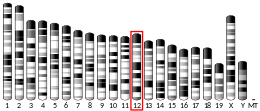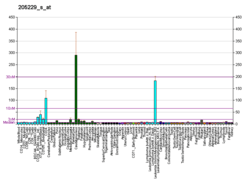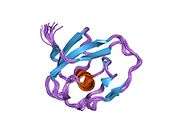Cochlin
Cochlin is a protein that in humans is encoded by the COCH gene.[5][6] It is an extracellular matrix (ECM) protein highly abundant in the cochlea and vestibule of the inner ear, constituting the major non-collagen component of the ECM of the inner ear.[7][8] The protein is highly conserved in human, mouse, and chicken, showing 94% and 79% amino acid identity of human to mouse and chicken sequences, respectively.[6]
Structure
Cochlin contains three protein domains: an N-terminal LCCL domain, and two copies of Von Willebrand factor type A domains.[9]
Function
The gene is expressed in spindle-shaped cells located along nerve fibers between the auditory ganglion and sensory epithelium. These cells accompany neurites at the habenula perforata, the opening through which neurites extend to innervate hair cells. This and the pattern of expression of this gene in chicken inner ear paralleled the histologic findings of acidophilic deposits, consistent with mucopolysaccharide ground substance, in temporal bones from DFNA9 (autosomal dominant nonsyndromic sensorineural deafness 9) patients. Mutations that cause DFNA9 have been reported in this gene.[6]
Cochlin has been identified in the trabecular meshwork (TM) of glaucoma patients, but not in healthy controls. The TM is a filter like area of tissue in the eye; cochlin may have a role in cell adhesion, mechanosensation, and modulation of the TM filter.[10][11]
It is also expressed in follicular dendritic cells in spleen and lymph nodes. Here, cochlin is cleaved by aggrecanases and secreted into blood circulation during inflammation, contributing to the antibacterial innate immune response.[12]
References
- GRCh38: Ensembl release 89: ENSG00000100473 - Ensembl, May 2017
- GRCm38: Ensembl release 89: ENSMUSG00000020953 - Ensembl, May 2017
- "Human PubMed Reference:". National Center for Biotechnology Information, U.S. National Library of Medicine.
- "Mouse PubMed Reference:". National Center for Biotechnology Information, U.S. National Library of Medicine.
- Robertson NG, Lu L, Heller S, Merchant SN, Eavey RD, McKenna M, Nadol JB, Miyamoto RT, Linthicum FH, Lubianca Neto JF, Hudspeth AJ, Seidman CE, Morton CC, Seidman JG (November 1998). "Mutations in a novel cochlear gene cause DFNA9, a human nonsyndromic deafness with vestibular dysfunction". Nature Genetics. 20 (3): 299–303. doi:10.1038/3118. PMID 9806553.
- "Entrez Gene: COCH coagulation factor C homolog, cochlin (Limulus polyphemus)".
- Robertson NG, Skvorak AB, Yin Y, Weremowicz S, Johnson KR, Kovatch KA, Battey JF, Bieber FR, Morton CC (December 1997). "Mapping and characterization of a novel cochlear gene in human and in mouse: a positional candidate gene for a deafness disorder, DFNA9". Genomics. 46 (3): 345–54. doi:10.1006/geno.1997.5067. PMID 9441737.
- Ikezono T, Omori A, Ichinose S, Pawankar R, Watanabe A, Yagi T (March 2001). "Identification of the protein product of the Coch gene (hereditary deafness gene) as the major component of bovine inner ear protein". Biochimica et Biophysica Acta (BBA) - Molecular Basis of Disease. 1535 (3): 258–65. doi:10.1016/s0925-4439(00)00101-0. PMID 11278165.
- "Cochlin (O43405)". InterPro < EMBL-EBI.
- Goel M, Sienkiewicz AE, Picciani R, Lee RK, Bhattacharya SK (2011). "Cochlin induced TREK-1 co-expression and annexin A2 secretion: role in trabecular meshwork cell elongation and motility". PLOS ONE. 6 (8): e23070. doi:10.1371/journal.pone.0023070. PMC 3160293. PMID 21886777.
- Picciani R, Desai K, Guduric-Fuchs J, Cogliati T, Morton CC, Bhattacharya SK (September 2007). "Cochlin in the eye: functional implications". Progress in Retinal and Eye Research. 26 (5): 453–69. doi:10.1016/j.preteyeres.2007.06.002. PMC 2064858. PMID 17662637.
- Py BF, Gonzalez SF, Long K, Kim MS, Kim YA, Zhu H, Yao J, Degauque N, Villet R, Ymele-Leki P, Gadjeva M, Pier GB, Carroll MC, Yuan J (May 2013). "Cochlin produced by follicular dendritic cells promotes antibacterial innate immunity". Immunity. 38 (5): 1063–72. doi:10.1016/j.immuni.2013.01.015. PMC 3758559. PMID 23684986.
Further reading
- Khetarpal U, Schuknecht HF, Gacek RR, Holmes LB (September 1991). "Autosomal dominant sensorineural hearing loss. Pedigrees, audiologic findings, and temporal bone findings in two kindreds". Archives of Otolaryngology–Head & Neck Surgery. 117 (9): 1032–42. doi:10.1001/archotol.1991.01870210104022. PMID 1910721.
- Robertson NG, Khetarpal U, Gutiérrez-Espeleta GA, Bieber FR, Morton CC (September 1994). "Isolation of novel and known genes from a human fetal cochlear cDNA library using subtractive hybridization and differential screening". Genomics. 23 (1): 42–50. doi:10.1006/geno.1994.1457. PMID 7829101.
- Khetarpal U (January 1993). "Autosomal dominant sensorineural hearing loss. Further temporal bone findings". Archives of Otolaryngology–Head & Neck Surgery. 119 (1): 106–8. doi:10.1001/archotol.1993.01880130108016. PMID 8417734.
- Manolis EN, Yandavi N, Nadol JB, Eavey RD, McKenna M, Rosenbaum S, Khetarpal U, Halpin C, Merchant SN, Duyk GM, MacRae C, Seidman CE, Seidman JG (July 1996). "A gene for non-syndromic autosomal dominant progressive postlingual sensorineural hearing loss maps to chromosome 14q12-13". Human Molecular Genetics. 5 (7): 1047–50. doi:10.1093/hmg/5.7.1047. PMID 8817345.
- de Kok YJ, Bom SJ, Brunt TM, Kemperman MH, van Beusekom E, van der Velde-Visser SD, Robertson NG, Morton CC, Huygen PL, Verhagen WI, Brunner HG, Cremers CW, Cremers FP (February 1999). "A Pro51Ser mutation in the COCH gene is associated with late onset autosomal dominant progressive sensorineural hearing loss with vestibular defects". Human Molecular Genetics. 8 (2): 361–6. doi:10.1093/hmg/8.2.361. PMID 9931344.
- Fransen E, Verstreken M, Verhagen WI, Wuyts FL, Huygen PL, D'Haese P, Robertson NG, Morton CC, McGuirt WT, Smith RJ, Declau F, Van de Heyning PH, Van Camp G (August 1999). "High prevalence of symptoms of Menière's disease in three families with a mutation in the COCH gene". Human Molecular Genetics. 8 (8): 1425–9. doi:10.1093/hmg/8.8.1425. PMID 10400989.
- Kamarinos M, McGill J, Lynch M, Dahl H (April 2001). "Identification of a novel COCH mutation, I109N, highlights the similar clinical features observed in DFNA9 families". Human Mutation. 17 (4): 351. doi:10.1002/humu.37. PMID 11295836.
- Boulassel MR, Tomasi JP, Deggouj N, Gersdorff M (September 2001). "COCH5B2 is a target antigen of anti-inner ear antibodies in autoimmune inner ear diseases". Otology & Neurotology. 22 (5): 614–8. doi:10.1097/00129492-200109000-00009. PMID 11568667.
- Liepinsh E, Trexler M, Kaikkonen A, Weigelt J, Bányai L, Patthy L, Otting G (October 2001). "NMR structure of the LCCL domain and implications for DFNA9 deafness disorder". The EMBO Journal. 20 (19): 5347–53. doi:10.1093/emboj/20.19.5347. PMC 125649. PMID 11574466.
- Robertson NG, Resendes BL, Lin JS, Lee C, Aster JC, Adams JC, Morton CC (October 2001). "Inner ear localization of mRNA and protein products of COCH, mutated in the sensorineural deafness and vestibular disorder, DFNA9". Human Molecular Genetics. 10 (22): 2493–500. doi:10.1093/hmg/10.22.2493. PMID 11709536.
- Robertson NG, Hamaker SA, Patriub V, Aster JC, Morton CC (July 2003). "Subcellular localisation, secretion, and post-translational processing of normal cochlin, and of mutants causing the sensorineural deafness and vestibular disorder, DFNA9". Journal of Medical Genetics. 40 (7): 479–86. doi:10.1136/jmg.40.7.479. PMC 1735525. PMID 12843317.
- Grabski R, Szul T, Sasaki T, Timpl R, Mayne R, Hicks B, Sztul E (October 2003). "Mutations in COCH that result in non-syndromic autosomal dominant deafness (DFNA9) affect matrix deposition of cochlin". Human Genetics. 113 (5): 406–16. doi:10.1007/s00439-003-0992-7. PMID 12928864.
- Lemaire FX, Feenstra L, Huygen PL, Fransen E, Devriendt K, Van Camp G, Vantrappen G, Cremers CW, Wackym PA, Koss JC (September 2003). "Progressive late-onset sensorineural hearing loss and vestibular impairment with vertigo (DFNA9/COCH): longitudinal analyses in a belgian family". Otology & Neurotology. 24 (5): 743–8. doi:10.1097/00129492-200309000-00009. PMID 14501450.
- Usami S, Takahashi K, Yuge I, Ohtsuka A, Namba A, Abe S, Fransen E, Patthy L, Otting G, Van Camp G (October 2003). "Mutations in the COCH gene are a frequent cause of autosomal dominant progressive cochleo-vestibular dysfunction, but not of Meniere's disease". European Journal of Human Genetics. 11 (10): 744–8. doi:10.1038/sj.ejhg.5201043. PMID 14512963.
- Anderson NL, Polanski M, Pieper R, Gatlin T, Tirumalai RS, Conrads TP, Veenstra TD, Adkins JN, Pounds JG, Fagan R, Lobley A (April 2004). "The human plasma proteome: a nonredundant list developed by combination of four separate sources". Molecular & Cellular Proteomics. 3 (4): 311–26. doi:10.1074/mcp.M300127-MCP200. PMID 14718574.






